The Yangtze River Valley experienced several disastrous rainfall events throughout the record-breaking Meiyu season in 2020. In addition to the abundant precipitation over eastern China, it is the excessive precipitation throughout the entire Yangtze River that makes the Meiyu season extraordinarily different. However, the mechanism of the extreme precipitation over the upper reaches of the Yangtze River remains unclear.
A study published in
Quarterly Journal of the Royal Meteorological Society, by researchers from the Institute of Atmospheric Physics of the Chinese Academy of Science, gives clues that the activities of high-potential vorticity (PV) systems during their eastward propagation over the eastern Tibetan Plateau should be responsible for the above-normal rainfall not only over western China but also over eastern China.
"The activity of high-PV systems is characterized by a prominent diurnal cycle," said Dr. MA Tingting, the lead author of the study. "And their formation is closely related to the thermal contrast between the near-surface and lower atmosphere." In the morning, surface sensible heating increases sharply after sunrise, leading to a decrease in diabatic heating with height. Accordingly, PV weakens in the lower atmosphere, and the formation of high-PV systems reaches a minimum. An increase in turbulence increases near-surface evaporation, which in turn reduces surface diabatic heating. At the same time, cloud formation increases diabatic heating at approximately 400 hPa. Consequently, the thermal contrast below 400 hPa leads to an increase in diabatic heating with height, favoring the generation of high-PV systems.
Compared with the climatology, an excessive water vapor supply from the anomalous anticyclone over the northern Bay of Bengal, forced by the Indian Ocean warming in 2020, contributes to a stronger thermal contrast and enhanced activity of high-PV systems over the Tibetan Plateau.
"We also investigated the conditions under which the high-PV systems may migrate from the Tibetan Plateau," said MA Tingting. It is the arrival timing of high-PV systems at the eastern flank of the Tibetan Plateau that plays an important role in the subsequent development of these systems. Early arrival in the afternoon or evening is generally accompanied by air convergence and sufficient water vapor supply downstream of the Tibetan Plateau, which favors the systems moving off the Tibetan Plateau and influencing precipitation downstream.
Schematic diagram of the evolution of a high-PV system over the Tibetan Plateau and its migration from the Tibetan Plateau. (Image by MA Tingting)
"Our results not only reveal the multi-scale interactions, but also explain how Indian Ocean, though far away from the Yangtze River, plays a role in record-breaking rainfall in the region via high-PV systems over the Tibetan Plateau." said Prof. LIU Yimin, the corresponding author of the study.
Citation:
Ma, T., Wu, G., Liu, Y. & Mao, J. (2022) Abnormal warm sea-surface temperature in the Indian Ocean, active potential vorticity over the Tibetan Plateau, and severe flooding along the Yangtze River in summer 2020. Quarterly Journal of the Royal Meteorological Society, 1–20. https://doi.org/10.1002/qj.4243
Media contact: Ms. LIN Zheng, jennylin@mail.iap.ac.cn

